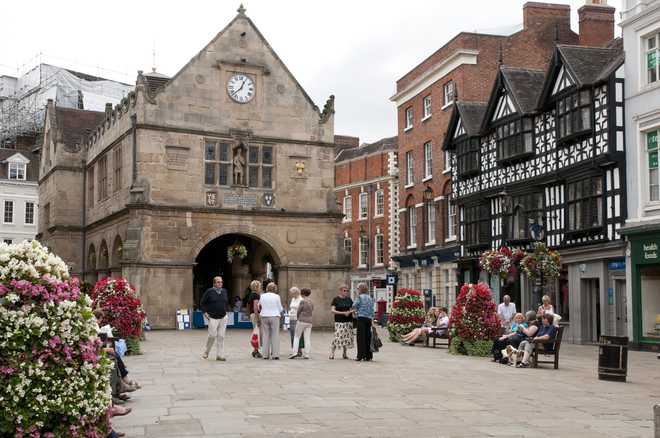Beyond black and white
Nivedita Ganguli
The elegant town of Shrewsbury on the border of England and Wales is an appealing day-trip and weekend destination for holidaymakers. The market town has more than 600 listed buildings, which means they are found in the Statutory List of Buildings of Special Architectural or Historic Interest in the UK.
Shrewsbury’s burgeoning wool trade during the Tudor era (1485-1603) saw rapid expansion of the town and proliferation of black-and-white, timber-framed houses. In London, it is virtually impossible to find a timber-framed house built before 1650 as the Great Fire of 1666 damaged most of the city. Shrewsbury, which stands on the Severn River, is teeming with such houses.
The narrow, steep and meandering Wyle Cop forms the heart of the town. It is a shopper’s paradise. Shops here are stocked with quirky designer clothes, cookware and antiques. It is a refreshing change from the usual high-street chain stores selling banal stuff.
Chocolate Gourmet, housed in an exquisite Tudor building and crammed full of truffles, pralines and nougat, is a delight.
The Lion and Pheasant Hotel, a 16th century coaching inn, has undergone major refurbishments. Henry Tudor House, located in Barracks Passage in Wyle Cop, is one of the oldest, half-timbered houses in the town. Built in the early 1400s, it was already 50 years old when Henry Tudor stopped here on his way to Bosworth to battle Richard III in 1485.
Today you can dine on pork belly, grilled asparagus, sweet potato and cauliflower biryani in the plush restaurant. The town was a veritable rabbit warren of passages, ‘shuts’ or alleyways in the medieval era. Many of these have been retained. Walking along the narrow Grope Lane, it is not difficult to imagine how people would have ‘groped’ their way through in the Middle Ages. The popular version suggests the area was a red light district!
Cross Keys, home to a well-heeled draper and constructed in 1575, stands at the end of Grope Lane. It now houses a coffee shop. The Owen’s Mansion has an interesting display of timber-framing. At one end of the town square is the statue of the controversial commander-in-chief of British India, Robert Clive, who was elected the town mayor in 1762 after his return from India.
A magnificent three-storied mansion that was home to wool merchant Robert Ireland in the 16th century still stands at the corner of High Street and Pride Hill. The house is now divided into shops and offices.
A trip to Shrewsbury is incomplete without a quick visit to the Market Hall. With its imposing Clock Tower, the hall is home to dozens of traders who deal in fruit, vegetables, antiques, books, meat, poultry and fish to name a few. Whether you are an architecture buff or addicted to shopping, Shrewsbury has ‘severn’ reasons to please you.










